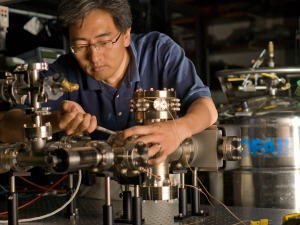HIGS Plays Role in Nuclear Fusion Research
A team that’s working to develop nuclear fusion as a power source is relying on the HIGS (High Intensity Gamma Ray Source) at Duke to test gamma ray detectors needed for the project.
Nuclear fission is already used to generate electricity in power plants around the world, but physicists are still working to develop a way to harness the power of nuclear fusion—the process that provides energy in stars such as our sun. One group of scientists working on the issue is the Gamma Ray Reaction History (GRH) team, made up of 11 scientists from Livermore National Laboratory, Los Alamos National Laboratory, and the Colorado School of Mines. This group is investigating a method whereby isotopes of hydrogen called deuterium (D) and tritium (T) are pushed close enough together to ignite a nuclear fusion reaction. The D-T fuel is placed in a small plastic capsule inside a gold cavity, and lasers are used to heat the inside walls of the gold cavity to superhot temperatures for about a 20 billionth of a second. In order to be viable as a source of energy, nuclear fusion needs to generate more energy than it takes to start the reaction, so it’s crucial that physicists be able to measure the D-T fusion reaction yield. Professor Mohammad Ahmed, who is the HIGS research coordinator, explains, “It is very important to look at two things: they need to know the yield of the D-T fusion reaction, and how efficiently D-T is burning.” Gamma rays can help answer both these questions. The fusion reaction also produces gamma rays with an energy of 16.8 MeV (megaelectron volt); measuring how many there are helps determine the energy yield. The efficiency of the reaction is indicated by the symmetry and uniformity of the ablation (instantaneous burn-off) of the plastic capsule holding the fuel. Neutrons from the fusion reaction interact with carbon atoms in the plastic capsule when it burns, producing 4.4 MeV gamma rays. The degree of symmetry of the 4.4 MeV gamma rays produced indicates the degree of symmetry of the ablation. The team is designing and building gamma ray detectors capable of measuring different characteristics of gamma rays at these energies. This is where HIGS comes in. HIGS is part of TUNL, the Triangle Universities Nuclear Laboratory, which is run jointly by Duke, UNC, and NC State and located at Duke. The GRH team is working with TUNL scientists to test the capabilities of the gamma ray detectors because HIGS can produce the types of gamma rays produced by D-T fusion. “HIGS provides the intensities, beam tunability, and energy resolution unmatched elsewhere in the world,” Ahmed says. “From day one when this project was conceived they always had us in mind.” The GRH team came to TUNL in April and will be returning in mid-February. “They need to look at the behavior of the detector as gamma rays are coming from different angles and with variable intensities,” Ahmed says. TUNL scientists and the GRH team worked together to design, build, and install a device at HIGS that allowed them to rotate the detector with respect to the beam direction. “It allows them to study the behavior of their detector as if the gamma rays were coming from D-T fusion,” Ahmed says. Ahmed says there is some research and development on the part of the TUNL scientists as they work to produce beams with the characteristics required by the GRH team. “We are active partners with them in this research,” Ahmed says. “It’s an ongoing relationship.”




